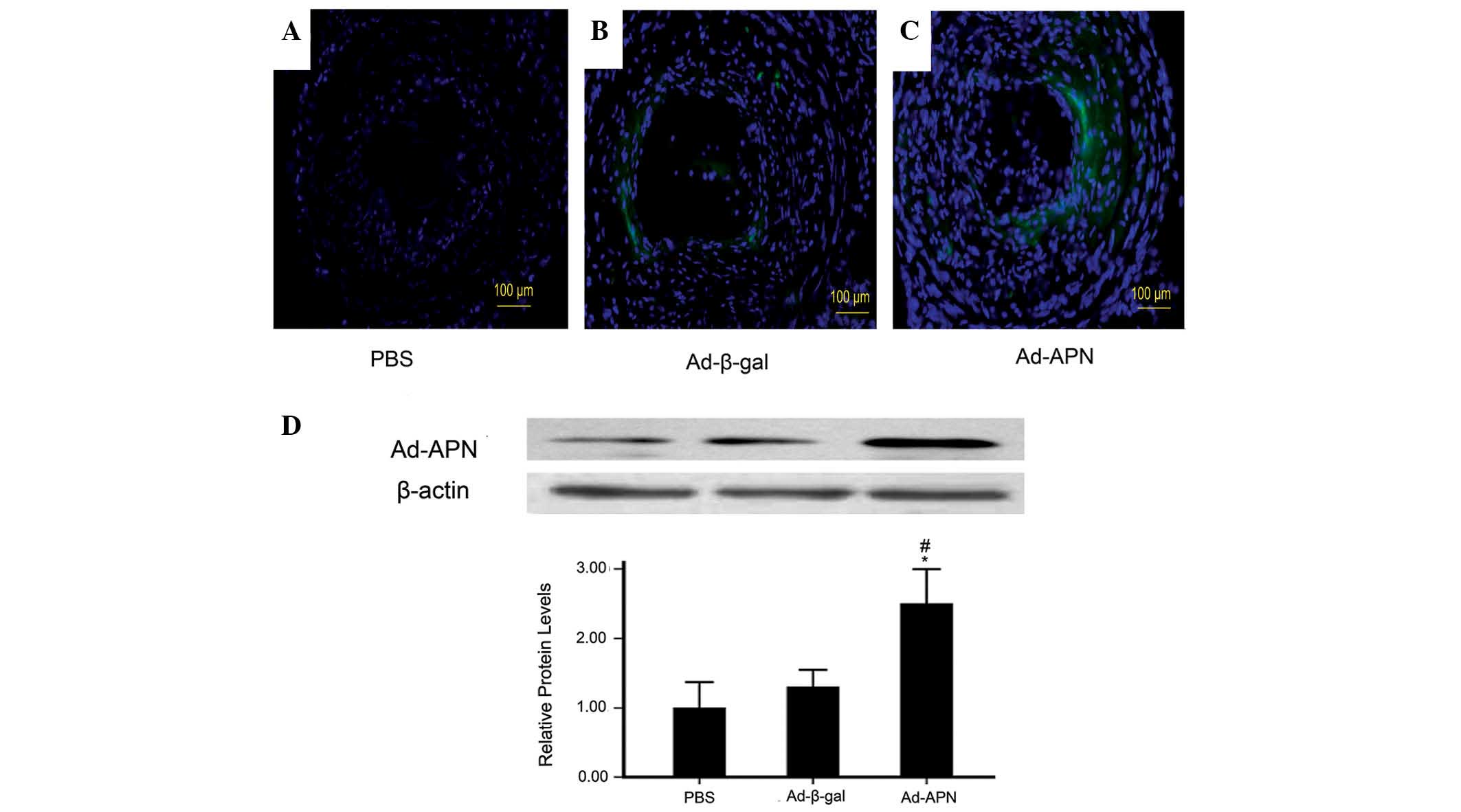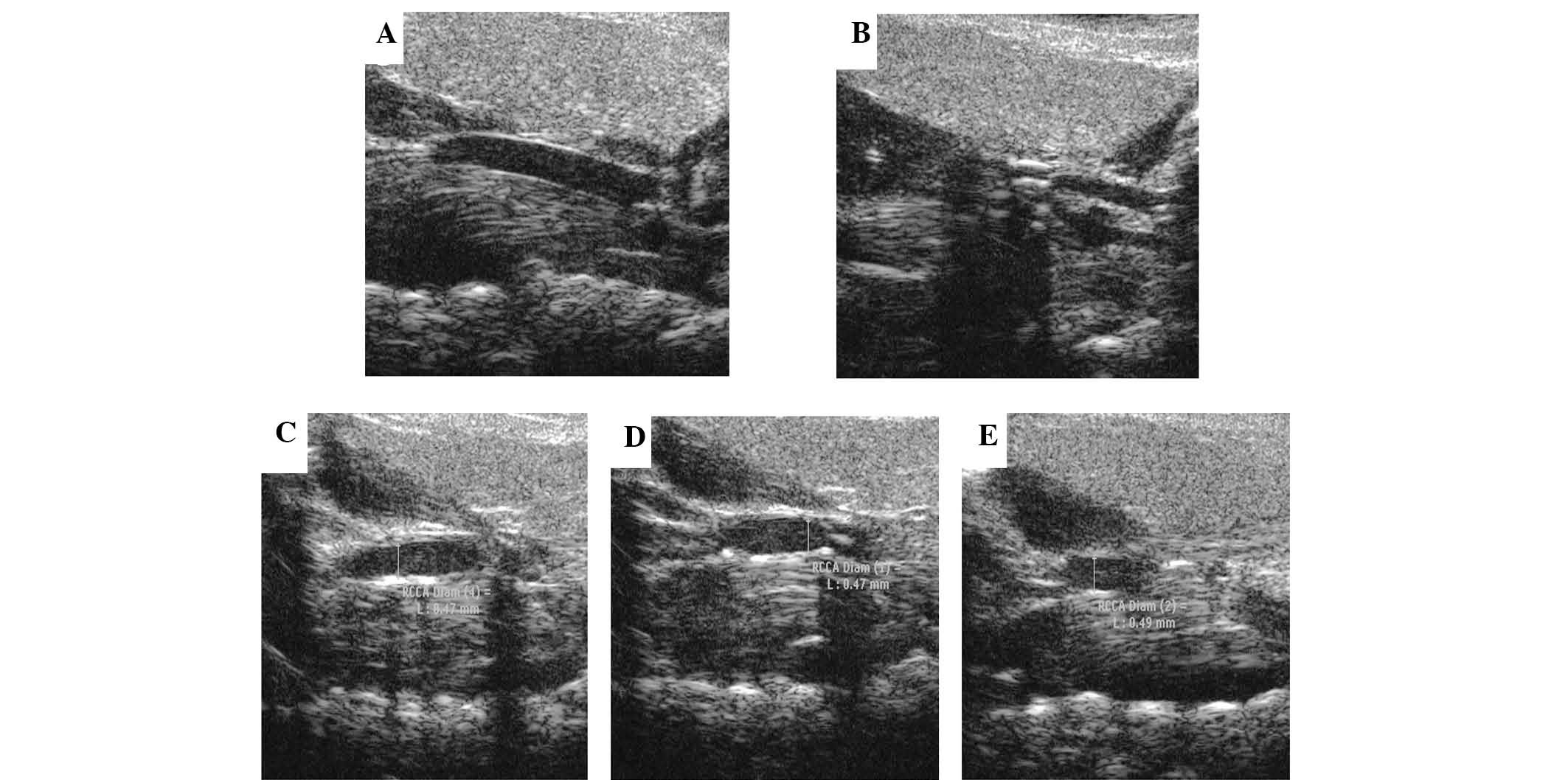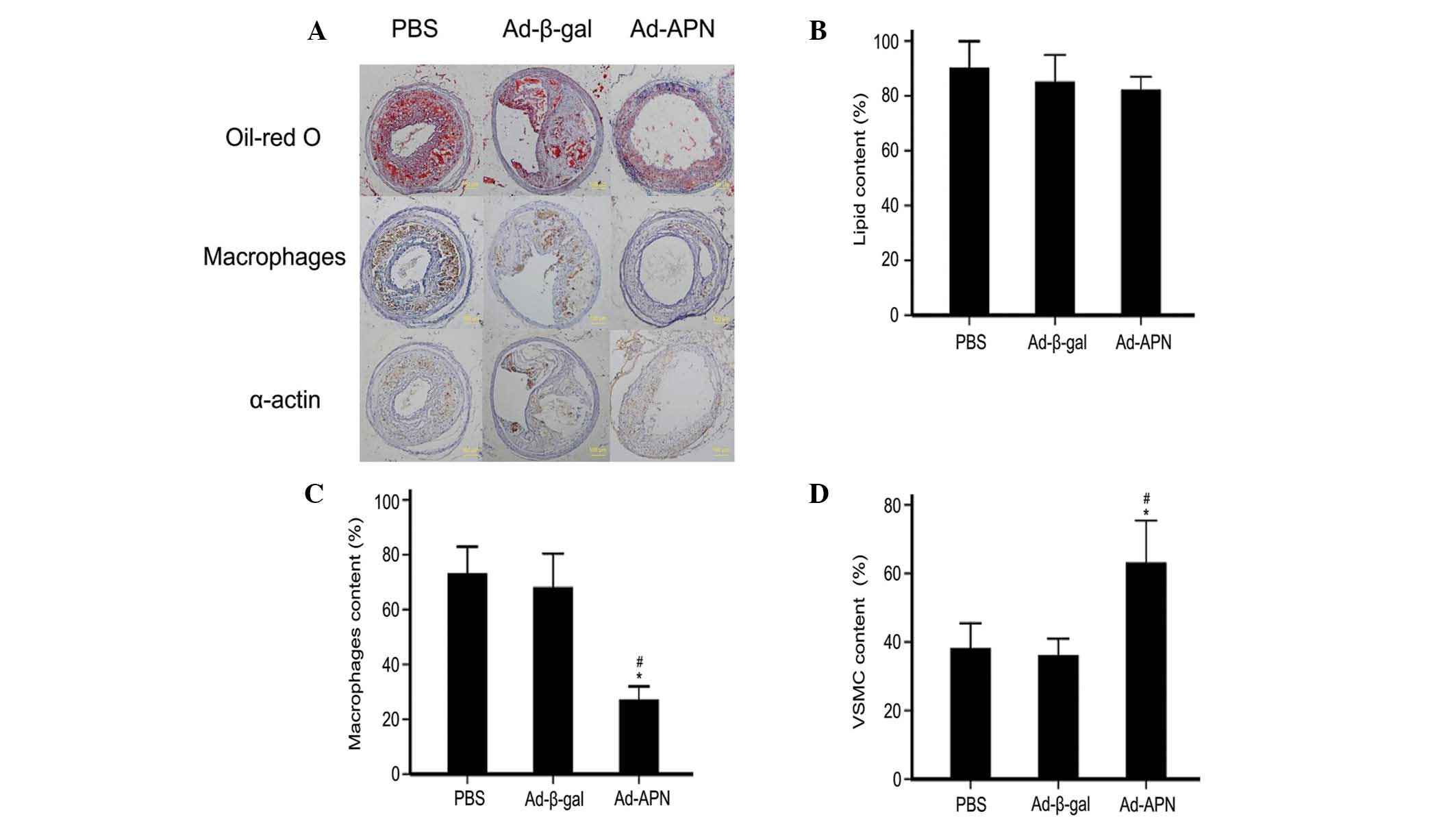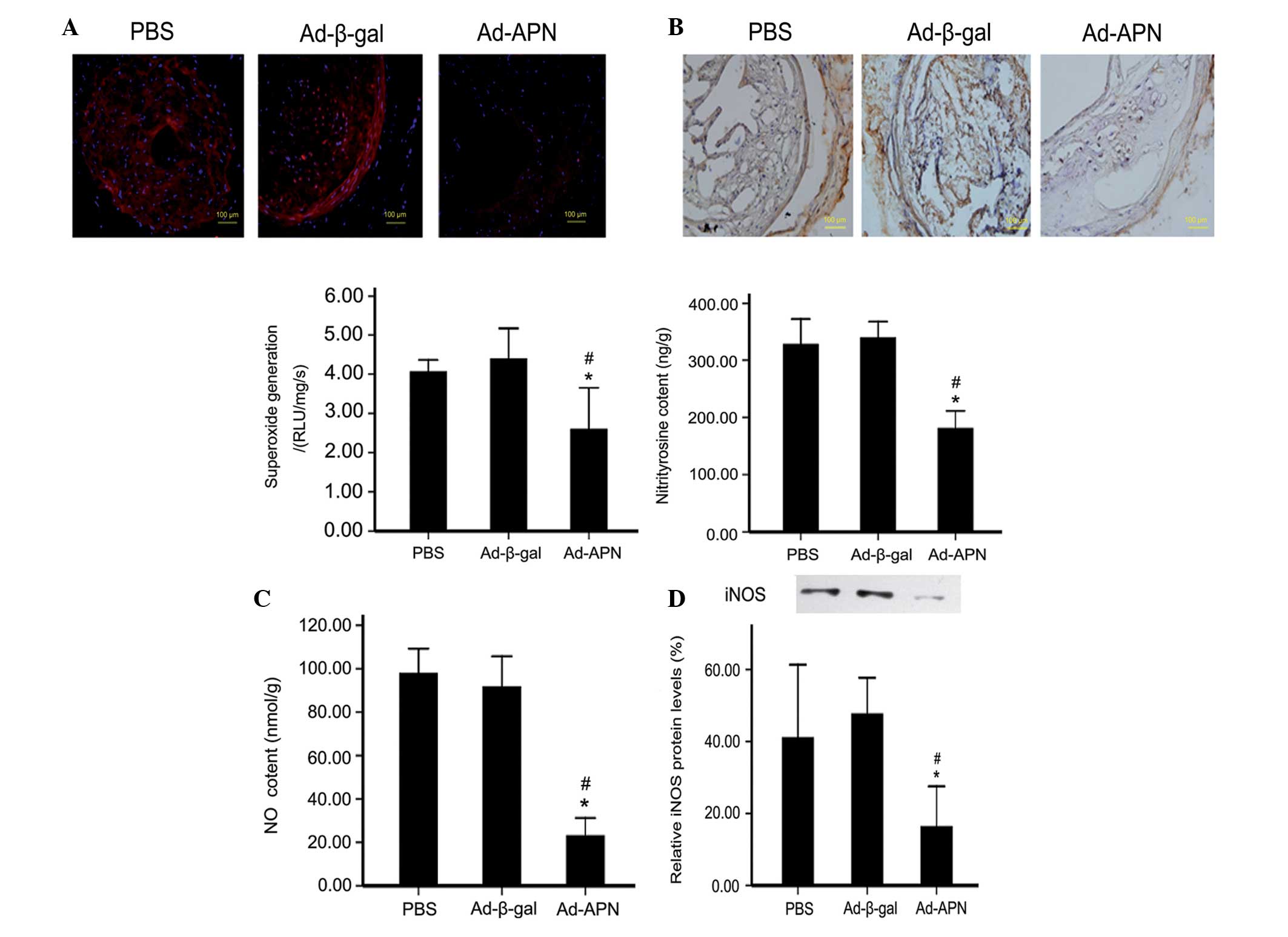Adiponectin reduces carotid atherosclerotic plaque formation in ApoE-/- mice: Roles of oxidative and nitrosative stress and inducible nitric oxide synthase
- Authors:
- Published online on: November 13, 2014 https://doi.org/10.3892/mmr.2014.2947
- Pages: 1715-1721
-
Copyright: © Cai et al. This is an open access article distributed under the terms of Creative Commons Attribution License [CC BY_NC 3.0].
Abstract
Introduction
All of the clinical and experimental studies on adiponectin (APN) markedly suggest that it is a critical vascular protective molecule and its reduction may contribute to vascular injury in metabolic disorder-associated diseases (1–5). Adiponectin is an adipose-specific plasma protein that has important roles in atherosclerosis, obesity and type 2 diabetes (6–8). Experimental studies have demonstrated that adiponectin has anti-inflammatory and anti-atherogenic properties. Previous studies have demonstrated that adiponectin overexpression reversed abnormal neointimal thickening in adiponectin-deficient mice and alleviated atherosclerotic lesions in apolipoprotein E-deficient (ApoE−/−) mice. Okamoto et al (9) reported that injection of an adenovirus containing adiponectin into ApoE−/− mice significantly reduced lesions within the aortic sinus region, and the results suggested that adiponectin may mediate its anti-atherogenic effects by adhering to macrophages and actin-negative cells (endothelial cells) within the fatty streak lesions. The study also revealed that adiponectin decreased the size of lipid droplets, vascular cell adhesion protein 1 expression and class A scavenger receptor without affecting lipid profiles in the plasma (9).
Oxidative stress, comprising the production of ·O2− and its derivative peroxynitrite (ONOO−), contributes to the onset of atherosclerosis (10). The levels of circulating adiponectin are inversely correlated with the plasma levels of oxidized low-density lipoprotein (LDL) in patients with type 2 diabetes and coronary artery disease, which suggests that low adiponectin levels are associated with an increased oxidative state in the arterial wall (11). Reduced adiponectin levels have also been correlated with increased levels of systemic oxidative stress (12). Furthermore, elevated endothelial reactive oxygen species (ROS) production stimulated by multiple agonists, including oxidized adiponectin and high glucose levels, was dose-dependently suppressed in vitro by recombinant globular adiponectin (13–14). Adiponectin improved endothelial function in hyperlipidemic rats (15) and protected hearts against ischemia/reperfusion injury by reducing oxidative/nitrative stress (16). Therefore, adiponectin may be a potent anti-oxidative/nitrative stress agent. However, to the best of our knowledge, whether adiponectin overexpression reduces atherosclerotic plaque by acting on oxidative/nitrative stress has not been investigated to date.
Therefore, the present study aimed to determine the relevance of adiponectin and its attenuation of oxidative stress. It was identified that adiponectin may reduce atherosclerotic plaque and improve the stability of plaques in ApoE−/− mice with atherosclerosis by inhibiting inducible nitric oxide synthase (iNOS) and oxidative/nitrative stress.
Materials and methods
Animals
The adenovirus producing the full-length adiponectin was constructed with use of the Adenovirus (Ad) Expression Vector kit (Takara, Kyoto, Japan) as described previously (17). From the effects of different titers of Ad-APN on serum adiponectin concentration in mice by ELISA, the optimal concentration of Ad-APN of 2×108 plaque-forming units [pfu] of infection was used.
Male ApoE−/− mice (10–12 weeks old; Beijing University, Beijing, China) were housed at room temperature (24°C) under a 12-h dark/light cycle and received a high-fat diet (0.25% cholesterol and 15% cocoa butter) for 12 weeks. Carotid atherosclerotic lesions were induced by surgical placement of perivascular constrictive silica collars (Shandog Medical Instrument Institute, Shandong, China) on the left common carotid arteries as described by our group previously (17). Eight weeks following surgery, the mice were divided into three groups for treatment (n=30/group): Phosphate-buffered saline (PBS), Ad-β-galactosidase (Ad-β-gal) and Ad-APN groups. The silica collars on the left common carotid arteries were removed carefully. PBS, Ad-β-gal and Ad-APN were trickled into the silica collar parts of common carotid arteries of mice. Two weeks following treatment, the mice were sacrificed and carotids were excised. The experiment conformed with the Guide for the Care and Use of Laboratory Animals published by the US National Institutes of Health (NIH Publication no. 85–23, revised 1985) and Shandong University guidelines (Shandong, China). This study was approved by the ethics committee of Jinan Central Hospital affiliated to Shandong University (Jinan, China).
Micro-ultrasonography
The Vevo770 ultrasonography system (Visualsonics, Toronto, Canada; 55-MHz scan head, 4.5-mm focus, axial resolution 30 μM) was used to measure the baseline parameters of the left carotid artery at the beginning of the experiment prior to and following transfection as previously described (18).
Histology
Frozen carotid-artery cross-sections (10-μM thick) embedded in optimal cutting temperature compound (OCT; Sakura Finetechnical Co., Ltd., Tokyo, Japan) following overnight fixation in 10% formalin were mounted on slides. Three sections (200-μM apart) for each mouse were stained with Oil-red O (Ameresco, Solon, OH, USA) and Masson trichrome (Maxim-Bio, Fujian, China). The corresponding sections were measured by use of an automated image analysis system (Image-Pro Plus 5.0, Media Cybernetics, Rockville, MD, USA) attached to a color CCD video camera (BX51; Olympus Corp., Tokyo, Japan).
Determination of total nitric oxide (NO) in carotid tissue
The carotid tissue was rinsed and homogenized. The content of NO in the supernatant was determined using the Griess Reagent method (Nitric Oxide Assay kit, Beyotime, Shanghai; Siever 280i NO Analyzer) as described previously (17).
Quantification of superoxide production
In situ superoxide content was detected by dihydroethidium staining (DHE; Molecular Probes, Carlsbad, CA) as described previously(19). The carotid tissue superoxide content was determined by lucigenin-enhanced luminescence (20).
Immunoblotting
The protein from the carotid tissue homogenates was separated by SDS-PAGE, transferred to nitrocellulose membranes and incubated with monoclonal antibodies against adiponectin, iNOS (both Upstate Biotechnology, Inc., Lake Placid, NY, USA) and β-actin (Cell Signaling Technology, Inc., Beverly, MA, USA), then horseradish peroxidase-conjugated anti-mouse immunoglobulin G antibody (1:2,000, Cell Signaling Technology, Inc., Danvers, MA, USA) for 1 h. The blots were developed by using a supersignal chemiluminescence kit (Pierce Biotechnology, Inc., Rockford, IL, USA) and visualized using a Kodak Image Station 400 (Amersham Pharmacia, Deisenhofen, Germany). The sample loadings were normalized with anti-β-actin polyclonal antibody (Sigma-Aldrich, St. Louis, MO, USA) and quantification involved use of the Image Station 2000R system (Eastman Kodak, Rochester, NY, USA).
Immunohistochemistry
Paraformaldehyde-fixed tissues were cut into semi-thin sections 4–5-μM thick and stained with the following antibodies: mouse anti-macrophage/monocyte monoclonal (clone MOMA-2; 1:500; Millipore, Billerica, MA, USA), mouse anti-human anti-α-actin (1:500; Millipore) and mouse anti-nitrotyrosine (clone 1A6; 1:200; Millipore). Immunohistochemistry staining was developed using a Vectastain ABC kit (Vector Laboratories, Burlingame, CA, USA).
Determination of plasma APN concentration
Plasma adiponectin levels were determined by use of a mouse adiponectin ELISA kit (Phoenix Pharmaceuticals, Inc., Belmont, CA, USA) according to the manufacturer’s instructions.
Quantification of tissue nitrotyrosine content
The nitrotyrosine content in the carotid tissue, indicating in vivo ONOO− formation, an index of nitrative stress, was determined by use of a nitrotyrosine ELISA kit (Cell Sciences, Canton, MA, USA) according to the manufacturer’s instructions.
Statistical analysis
All data are expressed as the mean ± standard error. Comparisons between the various groups were analyzed by one-way analysis of variance followed by Dunnett’s post-hoc test using SPSS 16.0 software (International Business Machines, Armonk, NY, USA). P<0.05 (two-sided) was considered to indicate a statistically significant difference.
Results
Ad-APN transfection increased APN levels in carotid arteries of ApoE−/− mice
On the 7th day following virus injection, the expression of virus-targeted genes was detectable in the mice, without loss of weight. As demonstrated in Fig. 1A–C, ~50% GFP expression in the Ad-APN plaques and 52% in the Ad-β-gal plaques but not in PBS plaques indicated effective transfection.
Protein levels of adiponectin in the carotid tissue were further studied. The results demonstrated that protein levels of adiponectin in Ad-APN plaques were higher than those in the Ad-β-gal and PBS plaques (2.5±0.2 vs. 1.3±0.1; P<0.05; 2.5±0.2 vs. 1.0±0.15; P<0.05; Fig. 1D). There was no significant difference between the control groups (1.0±0.15 vs. 1.3±0.1; P>0.05; Fig. 1D). Therefore, Ad-APN transfection efficiently increased the levels of adiponectin in mouse carotid arteries.
APN reduces atherosclerotic lesions in carotid arteries in ApoE−/− mice
The present study used micro-ultrasonography to evaluate the plaques. Prior to surgery, the carotid intima of control mice was smooth (Fig. 2A). Six weeks following surgery, abundant atherosclerotic lesions were present in the lumen (Fig. 2B). The carotids were also compared following collar removal and 14 days of PBS treatment to demonstrate that this remained the same (Fig. 2B and C). The results revealed that the removal of the collar did not improve atherosclerosis itself, which was improved by Ad-APN only. Following two weeks of transfection, the lesion sizes in the APN group were significantly lower than those in the Ad-β-gal and PBS groups, while there was no significant difference between the control groups (Fig. 2C–E).
Based on the micro-ultrasonography results, the plaque composition was further analyzed (Fig. 3A). Transfection with Ad-APN did not decrease the lipid contents, as there was no significant difference between any of the groups (82 vs. 86%, P>0.05; 82% vs. 90%, P>0.05; 86 vs. 90%, P>0.05; Fig. 3B). Ad-APN transfection produced a higher macrophage content than Ad-β-gal transfection (73 vs. 68%; P<0.05), with no difference between the control groups (68 vs. 0.27%; P>0.05; Fig. 3C). Transfection with Ad-APN produced a greater vascular smooth muscle cell (VSMC) content than transfection with Ad-β-gal (63 vs. 36%; P<0.05), while there was no significant difference between the control groups (36 vs. 38%, P>0.05; Fig. 3D).
APN decreases superoxide, NO and ONOO− production in ApoE−/− mice
Oxidative and nitrative stresses are primary factors responsible for atherosclerosis. To further assess the mechanism of altered atherosclerotic lesions in ApoE−/− mice, superoxide and NO production were detected. As summarized in Fig. 4, Ad-APN transfection reduced the enhanced superoxide production in the carotid tissue of ApoE−/− mice, compared with that in the Ad-β-gal-transfected mice (2.47.1±0.9 vs. 4.43±0.6 RLU/mg/s); P<0.05; Fig. 4A), while there was no difference between the control groups (4.43±0.6 vs. 4.10±0.2 RLU/mg/s; P>0.05; Fig. 4A). In addition, NO production was decreased in the Ad-APN-treated mice as compared with the Ad-β-gal-treated mice (22±3 vs. 96±5 nmol/g; P<0.05; Fig. 4B), with no difference between the control groups (96±5 vs. 97±4 nmol/g; P>0.05; Fig. 4B). Therefore, adiponectin reduced atherosclerosis in ApoE−/− mice, possibly through reducing superoxide production and preventing NO destruction. In addition, the content of ONOO−, the biradical reaction product of superoxide and NO, was detected by measurement of nitrotyrosine, a marker of in vivo ONOO− production. It was identified that the nitrotyrosine content was reduced in the Ad-APN-treated mice compared with that in the Ad-β-gal-treated mice (189±12 vs. 331±13 ng/g; P<0.05; Fig. 4C), with no difference between the control groups (331±13 vs. 325±25 ng/g; P>0.05; Fig. 4C).
Treatment with adiponectin decreases NO production by downregulating iNOS expression in ApoE−/− mice
The aforementioned results suggested that the reduced superoxide production and prevention of NO destruction may contribute to the vasculoprotective effect of APN in ApoE−/− mice. To identify the molecular candidates responsible for this effect, the iNOS protein expression was determined. It was identified that iNOS activity was reduced in the Ad-APN-treated mice (P<0.05; Fig. 4D) compared with the Ad-β-gal-treated mice, with no difference between the control groups (P>0.05; Fig. 4D).
Discussion
Numerous studies have demonstrated that adiponectin is an important antiatherogenic adipocytokine that inhibits insulin resistance, inflammation and oxidative stress (21–25). In the present study, several important observations were noted. Firstly, adiponectin overexpression in atherosclerotic ApoE−/− mice significantly reduced the size and area of carotid atherosclerotic lesions and positively changed the formation of the lesions. Secondly, it was identified that inhibiting superoxide production, preserving NO from destruction and blocking the formation of toxic ONOO− are major mechanisms by which adiponectin exerts its antiatherosclerotic and vascular protective effects. Finally, adiponectin exerted an inhibitory effect on iNOS expression. Therefore, adiponectin reduces atherosclerosis, at least in part by antioxidative and antinitrative mechanisms, and may therefore be useful in the treatment of this condition.
Adiponectin is secreted by adipose tissue and has a significant role in the development of cardiovascular diseases. The incidence of cardiovascular mortality is increased in patients with low plasma adiponectin compared with that with higher plasma adiponectin levels (26). Furthermore, low adiponectin levels are associated with endothelial dysfunction and inflammation (27–29). Adiponectin infiltrates rapidly into the subendothelial space of the vascular wall when the endothelial barrier of the arterial wall is injured by balloon angioplasty (30) Another study documented that the overexpression of adiponectin actually reduced atherosclerosis through attenuating endothelial inflammatory response and macrophage-to-foam cell transformation in vivo (9). A previous study by our group also reported that transfection of Ad-APN in carotid arteries decreased the size and formation of atherosclerotic lesions (18). However, whether adiponectin reduces atherosclerosis by inhibiting iNOS and the resulting oxidative/nitrative stress remains to be confirmed by future studies.
Evidence suggests that common risk factors for atherosclerosis increase the risk of free ROS production from endothelial cells and from smooth muscle and adventitial cells (31). Hypercholesterolemia, diabetes mellitus, arterial hypertension, smoking, age and nitrate intolerance increase the production of free ROS, which includes superoxide anion (O2−), hydroxyl radical (OH−) and ONOO−. Superoxide reacts with NO at a near diffusion-limited rate, which is three times faster than the reaction between superoxide and superoxide dismutase (32). This reaction causes the inactivation of NO, a cytoprotective and vasodilatory molecule, and results in the formation of ONOO−, a highly reactive and cytotoxic molecule (33). However, adiponectin may significantly reverse this course. The present study provided direct evidence that adiponectin reduced the enhanced superoxide production in the carotid tissue of ApoE−/− mice. It was demonstrated that NO production was decreased in Ad-APN-treated mice. The content of ONOO−, the biradical reaction product of superoxide and NO, was detected by measurement of nitrotyrosine, a marker of in vivo ONOO− production, and the nitrotyrosine content was reduced with adiponectin pretreatment. Therefore, adiponectin reduced atherosclerosis in ApoE−/− mice, likely through reducing superoxide production and preserving NO destruction.
Oxidative/nitrative stress due to increased iNOS and superoxide production and subsequent cytotoxic ONOO− production are early hallmarks of vascular injury in patients with atherosclerosis. The physiological or pharmacological concentrations of NO exert significant cardioprotective effects, whereas the reaction product of NO and ·O2−, ONOO−, is highly cytotoxic. Several lines of evidence indicated that adiponectin improves endothelial function by its antioxidative/antinitrative properties and by enhancing eNOS activity, blocking iNOS and NADPH oxidase expression and ONOO− production (1,34–36). A previous study by our group on cultured adventitial fibroblasts also demonstrated that adiponectin inhibited iNOS activity and reduced excessive NO production (17). In the present study, it was identified that adiponectin downregulated iNOS expression in carotid tissues. Levels of iNOS expression were increased in the carotid artery of ApoE−/− mice and reduced significantly with overexpression of adiponectin. Further studies that examine these mechanisms may reveal novel signaling pathways that regulate iNOS activity.
In conclusion, these results demonstrated that adiponectin, as a unique cytokine, reduced atherosclerosis and attenuates oxidative/nitrative stress by blocking iNOS, superoxide and ONOO− production. The present study took a different approach and provided evidence that adiponectin expression significantly reduced atherosclerosis associated with oxidative/nitrative stress.
Acknowledgements
This study was supported by The National Basic Research Program of China (973 Program, 2011CB503906), Development Program of China (863 Program, 2007AA02Z448), the National Natural Science Foundation of China (nos. 30728025 and 30970709), National Natural Science Funds for Young Scholar (no. 81200211), grants from the Shandong Young Scientists Award Fund (no. BS2012SW003) and grants from Scientific and technology Development program of Jinan (nos. 201003125 and 200905035).
References
|
Li R, Wang WQ, Zhang H, et al: Adiponectin improves endothelial function in hyperlipidemic rats by reducing oxidative/nitrative stress and differential regulation of eNOS/iNOS activity. Am J Physiol Endocrinol Metab. 293:E1703–E1708. 2007. View Article : Google Scholar : PubMed/NCBI | |
|
Okui H, Hamasaki S, Ishida S, et al: Adiponectin is a better predictor of endothelial function of the coronary artery than HOMA-R, body mass index, immunoreactive insulin, or triglycerides. Int J Cardiol. 126:53–61. 2008. View Article : Google Scholar | |
|
Lee S, Park Y, Dellsperger KC and Zhang C: Exercise training improves endothelial function via adiponectin-dependent and independent pathways in type 2 diabetic mice. Am J Physiol Heart Circ Physiol. 301:H306–H314. 2011. View Article : Google Scholar : PubMed/NCBI | |
|
Lee S, Zhang H, Chen J, Dellsperger KC, Hill MA and Zhang C: Adiponectin abates diabetes-induced endothelial dysfunction by suppressing oxidative stress, adhesion molecules, and inflammation in type 2 diabetic mice. Am J Physiol Heart Circ Physiol. 303:H106–H115. 2012. View Article : Google Scholar : PubMed/NCBI | |
|
Ouchi N, Ohishi M, Kihara S, et al: Association of hypoadiponectinemia with impaired vasoreactivity. Hypertension. 42:231–234. 2003. View Article : Google Scholar : PubMed/NCBI | |
|
Arita Y, Kihara S, Ouchi N, et al: Paradoxical decrease of an adipose-specific protein, adiponectin, in obesity. Biochem Biophys Res Commun. 257:79–83. 1999. View Article : Google Scholar : PubMed/NCBI | |
|
Ouchi N, Kihara S, Arita Y, et al: Novel modulator for endothelial adhesion molecules: adipocyte-derived plasma protein adiponectin. Circulation. 100:2473–2476. 1999. View Article : Google Scholar : PubMed/NCBI | |
|
Hotta K, Funahashi T, Arita Y, et al: Plasma concentrations of a novel, adipose-specific protein, adiponectin, in type 2 diabetic patients. Arterioscler Thromb Vasc Biol. 20:1595–1599. 2000. View Article : Google Scholar : PubMed/NCBI | |
|
Okamoto Y, Kihara S, Ouchi N, et al: Adiponectin reduces atherosclerosis in apolipoprotein E-deficient mice. Circulation. 106:2767–2770. 2002. View Article : Google Scholar : PubMed/NCBI | |
|
Muscoli C, Cuzzocrea S, Riley DP, et al: On the selectivity of superoxide dismutase mimetics and its importance in pharmacological studies. Br J Pharmacol. 140:445–460. 2003. View Article : Google Scholar : PubMed/NCBI | |
|
Lautamäki R, Rönnemaa T, Huupponen R, et al: Low serum adiponectin is associated with high circulating oxidized low-density lipoprotein in patients with type 2 diabetes mellitus and coronary artery disease. Metabolism. 56:881–886. 2007. View Article : Google Scholar : PubMed/NCBI | |
|
Furukawa S, Fujita T, Shimabukuro M, et al: Increased oxidative stress in obesity and its impact on metabolic syndrome. J Clin Invest. 114:1752–1761. 2004. View Article : Google Scholar : PubMed/NCBI | |
|
Ouedraogo R, Wu X, Xu SQ, et al: Adiponectin suppression of high-glucose-induced reactive oxygen species in vascular endothelial cells: evidence for involvement of a cAMP signaling pathway. Diabetes. 55:1840–1846. 2006. View Article : Google Scholar : PubMed/NCBI | |
|
Motoshima H, Wu X, Mahadev K and Goldstein BJ: Adiponectin suppresses proliferation and superoxide generation and enhances eNOS activity in endothelial cells treated with oxidized LDL. Biochem Biophys Res Commun. 315:264–271. 2004. View Article : Google Scholar : PubMed/NCBI | |
|
Li R, Wang WQ, Zhang H, et al: Adiponectin improves endothelial function in hyperlipidemic rats by reducing oxidative/nitrative stress and differential regulation of eNOS/iNOS activity. Am J Physiol Endocrinol Metab. 293:E1703–E1708. 2007. View Article : Google Scholar : PubMed/NCBI | |
|
Tao L, Gao E, Jiao X, et al: Adiponectin cardioprotection after myocardial ischemia/reperfusion involves the reduction of oxidative/nitrative stress. Circulation. 115:1408–1416. 2007. View Article : Google Scholar : PubMed/NCBI | |
|
Cai XJ, Chen L, Li L, et al: Adiponectin inhibits lipopolysaccharide-induced adventitial fibroblast migration and transition to myofibroblasts via AdipoR1-AMPK-iNOS pathway. Mol Endocrinol. 24:218–228. 2010. View Article : Google Scholar | |
|
Li L, Cai XJ, Feng M, et al: Effect of adiponectin overexpression on stability of preexisting plaques by inducing prolyl-4-hydroxylase expression. Circ J. 74:552–559. 2010. View Article : Google Scholar : PubMed/NCBI | |
|
Zhao ZQ, Corvera JS, Halkos ME, et al: Inhibition of myocardial injury by ischemic postconditioning during reperfusion: comparison with ischemic preconditioning. Am J Physiol Heart Circ Physiol. 285:H579–H588. 2003.PubMed/NCBI | |
|
Tao L, Liu HR, Gao E, et al: Antioxidative, antinitrative, and vasculoprotective effects of a peroxisome proliferator-activated receptor-gamma agonist in hypercholesterolemia. Circulation. 108:2805–2811. 2003. View Article : Google Scholar : PubMed/NCBI | |
|
Sulistyoningrum DC, Gasevic D, Lear SA, Ho J, Mente A and Devlin AM: Total and high molecular weight adiponectin and ethnic-specific differences in adiposity and insulin resistance: a cross-sectional study. Cardiovasc Diabetol. 12:1702013. View Article : Google Scholar : PubMed/NCBI | |
|
Rabe K, Lehrke M, Parhofer KG and Broedl UC: Adipokines and insulin resistance. Mol Med. 14:741–751. 2008. View Article : Google Scholar : PubMed/NCBI | |
|
Fisman EZ and Tenenbaum A: Adiponectin: a manifold therapeutic target for metabolic syndrome, diabetes, and coronary disease? Cardiovasc Diabetol. 13:1032014. View Article : Google Scholar : PubMed/NCBI | |
|
Wang X, Pu H, Ma C, et al: Adiponectin abates atherosclerosis by reducing oxidative stress. Med Sci Monit. 20:1792–1800. 2014. View Article : Google Scholar : PubMed/NCBI | |
|
Essick EE, Wilson RM, Pimentel DR, et al: Adiponectin modulates oxidative stress-induced autophagy in cardiomyocytes. PLoS One. 8:e686972013. View Article : Google Scholar : PubMed/NCBI | |
|
Zoccali C, Mallamaci F, Tripepi G, et al: Adiponectin, metabolic risk factors, and cardiovascular events among patients with end-stage renal disease. J Am Soc Nephrol. 13:134–141. 2002. | |
|
Shimabukuro M, Higa N, Asahi T, et al: Hypoadiponectinemia is closely linked to endothelial dysfunction in man. J Clin Endocrinol Metab. 88:3236–3240. 2003. View Article : Google Scholar : PubMed/NCBI | |
|
Tan KC, Xu A, Chow WS, et al: Hypoadiponectinemia is associated with impaired endothelium-dependent vasodilation. J Clin Endocrinol Metab. 89:765–769. 2004. View Article : Google Scholar : PubMed/NCBI | |
|
Fernández-Real JM, Castro A, Vázquez G, et al: Adiponectin is associated with vascular function independent of insulin sensitivity. Diabetes Care. 27:739–745. 2004. View Article : Google Scholar : PubMed/NCBI | |
|
Okamoto Y, Arita Y, Nishida M, et al: An adipocyte-derived plasma protein, adiponectin, adheres to injured vascular walls. Horm Metab Res. 32:47–50. 2000. View Article : Google Scholar : PubMed/NCBI | |
|
Gozin A, Franzini E, Andrieu V, et al: Reactive oxygen species activate focal adhesion kinase, paxillin and p130cas tyrosine phosphorylation in endothelial cells. Free Radic Biol Med. 25:1021–1032. 1998. View Article : Google Scholar : PubMed/NCBI | |
|
Huie RE and Padmaja S: The reaction of NO with superoxide. Free Radic Res Commun. 18:195–199. 1993. View Article : Google Scholar : PubMed/NCBI | |
|
Beckman JS and Koppenol WH: Nitric oxide, superoxide, and peroxynitrite: the good, the bad, and the ugly. Am J Physiol Cell Physiol. 271:C1424–C1437. 1996. | |
|
Margaritis M, Antonopoulos AS, Digby J, et al: Interactions between vascular wall and perivascular adipose tissue reveal novel roles for adiponectin in the regulation of endothelial nitric oxide synthase function in human vessels. Circulation. 127:2209–2221. 2013. View Article : Google Scholar : PubMed/NCBI | |
|
Zheng Q, Yuan Y, Yi W, et al: C1q/TNF-related proteins, a family of novel adipokines, induce vascular relaxation through the adiponectin receptor-1/AMPK/eNOS/nitric oxide signaling pathway. Arterioscler Thromb Vasc Biol. 31:2616–2623. 2011. View Article : Google Scholar : PubMed/NCBI | |
|
Li R, Xu M, Wang X, et al: Reduced vascular responsiveness to adiponectin in hyperlipidemic rats - mechanisms and significance. J Mol Cell Cardiol. 49:508–515. 2010. View Article : Google Scholar : PubMed/NCBI |













